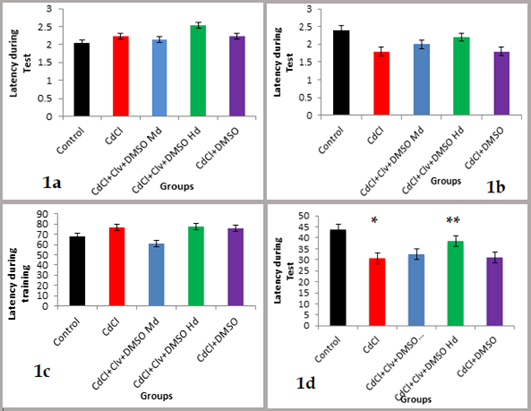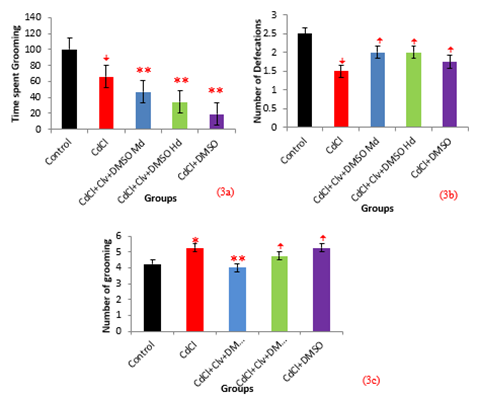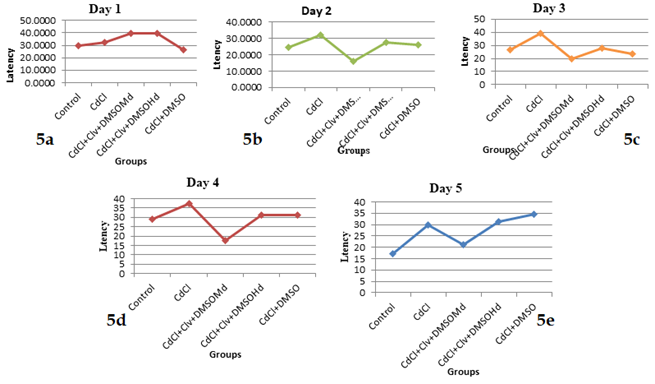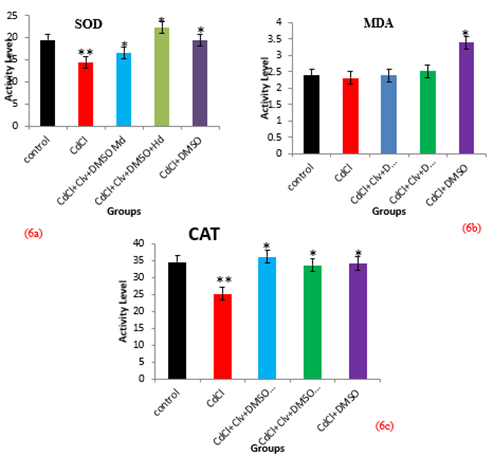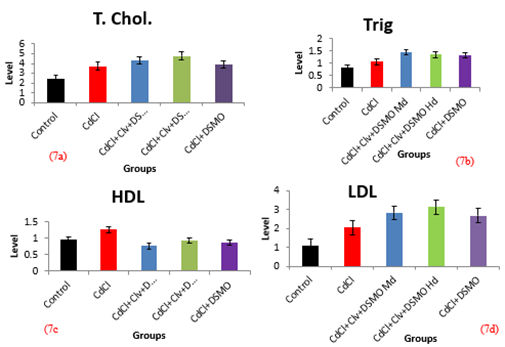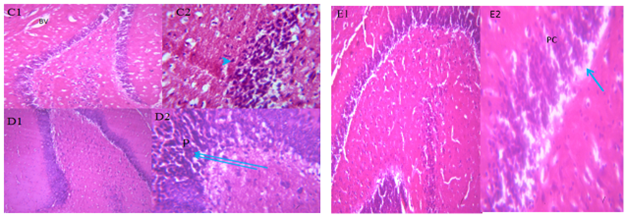Research article
The Roles of Clove Essential Oil in Increased Contextual Fear, Impaired Memory, And Exploratory Behaviors Associated with Cadmium Neurotoxicity in Rat Model
- Uchewa O. Obinna 1*
- Oko M. Chidimma 1
- Cookey-Gam B. Tamunoibelema 1
- Okoronkwo O. Samuel 2
- Asikaro Jude 1
- Anyigor O. Okechukwu 1
- Ibegbu O. Augustine 1
1Department of Anatomy, Alex Ekwueme, Federal University, Ndufu-Alike, Ikwo, Ebonyi, Nigeria.
2Department of Anatomy, David Umahi Federal University of Health Sciences, Uburu, Ebonyi, Nigeria.
*Corresponding Author: Uchewa O. Obinna. Department of Anatomy, Alex Ekwueme, Federal University, Ndufu-Alike, Ikwo, Ebonyi, Nigeria
Citation: Uchewa OO, Oko MC, Cookey-Gam BT, Okoronkwo OS, Asikaro J. et al. (2023). The Roles of Clove Essential Oil in Increased Contextual Fear, Impaired Memory, And Exploratory Behaviors Associated with Cadmium Neurotoxicity in Rat Model, Journal of Brain Research and Neurology, BioRes Scientia Publishers. 2(1):1-13; DOI: 10.59657/2992-9768.brs.23.006
Copyright: © 2023 Uchewa O. Obinna, this is an open-access article distributed under the terms of the Creative Commons Attribution License, which permits unrestricted use, distribution, and reproduction in any medium, provided the original author and source are credited
Received: July 10, 2023 | Accepted: August 16, 2023 | Published: September 27, 2023
Abstract
Background: Many people use Clove oil (CLO) as an antiseptic and analgesic.
Objective: The study investigated the potency of CLO for impaired spatial memory and motor activities due to CdCl neurotoxicity in rodents.
Methods: 35 Wistar rats were randomly grouped into five of seven animals per group after 14 days of acclimatization. The control received feed and water, B received 10mg/kg of CdCl, C received 10mg/kg of CdCl + 10mg/kg of CLO, D received 10mg/kg of CdCl + 10mg/kg of CLO; and E received 10mg/kg of CdCl + 10mg/kg of DMSO. The DMSO served as a vehicle for dissolving CLO. CdCl induction lasted 14 days, followed by 14 days of CLO. Memory, contextual fear, exploratory behavior, and anxiety were all measured using the Morris Water Maze and the Open Field Test (OFT). Total Cholesterol (TC), triglyceride (Trig), High-Density Lipoprotein (HDL), and Low-Density Lipoprotein (LDL) concentrations were estimated too.
Results: The untreated group showed a significant increase in TC, triglycerides, and LDL, which was lowered by the essential oil. There was a decrease in grip strength latency and anxiety in untreated groups at p<0.05, shown by alterations in Figures 8 and 9. Generally, toxicity caused a memory deficit with increased latency at p<0.05 and was improved by CLO (Figure 5a-e). Conclusion: Clove oil improves motor activities, and spatial memory, and reduces anxiety.
Keywords: cadmium; clove oil; locomotive; motor learning; neurotoxicity; spatial memory
Introduction
Cadmium (Cd), the seventh most toxic heavy metal among environmental pollutants, is widely distributed in nature and industrial sources (ATSDR, 2017), and even though it occurs naturally, over 90% within the environment are due to industrial and agricultural activities (Pan et al., 2010). Reactive oxygen species have been acknowledged as the leading cause of oxidative stress (Schieber and Chandel, 2014). Although the cells can combat ROS accumulation via oxidative stress response, it is often insufficient and thus leads to severe oxidative stress (Birben et al., 2012). Cadmium exposure induces apparent microstructure alterations of the cerebral cortex in juvenile mice, which may be a critical mechanism of cadmium neurotoxicity (Yang et al., 2015). The cerebellum is an important part of the human brain and plays a vital role in the regulation of movement and balance (Roostaei et al., 2014).
Clove has been used as a traditional medicine for centuries as an antiseptic, analgesic, and even in dental care (Chaib et al., 2007). Recent studies have documented a range of biological effects of clove including antibacterial (Kamilla et al., 2018 and Nissan et al., 2015), antifungal (Liu et al., 2017), antimutagenic (Sultana et al., 2014), anti-inflammatory (Han et al., 2017), antioxidant (Harlina et al., 2018), and antiproliferative activity (Das et al., 2018). The high levels of eugenol in clove essential oil are responsible for its biological solid and antimicrobial activities (Chaib et al., 2007). In recent decades, cadmium (Cd) poisoning has been a significant public health risk, particularly in developing countries. Furthermore, shared evidence suggests that even low-level cadmium exposure significantly promotes neurodegeneration in different brain regions (Guadalupe et al., 2019). Over the last decades, the use of aromatic plants for medicinal purposes has gained significant interest (Grush et al., 2004). In addition, bioactive compounds from clove buds have been widely studied regarding their antioxidant activities (Gülcin et al., 2012). However, there is limited information on the effect of clove oil on cadmium-induced neurotoxicity on memory, contextual fear, motor activities and exploratory behaviors in rat’s models. Hence, this study needs to ascertain the role of clove oil on cadmium-induced neurotoxicity using rat’s model.
Materials and Methods
Sourcing of Chemicals and Reagents
The cadmium chloride and Dimethyl Sulfoxide (DMSO) used in this research were gotten from Sigma Aldrich, USA. The Cadmium Chloride was 99.9% pure and came in a pack of 500g with a product code of CD-CL-03, while DMSO was for molecular biology with a product code of D8418, which was also 99.9% and came in a bottle of 100ml. The clove essential oil was purchased from Roban supermarket in Abakaliki Ebonyi State. It came in a bottle of 30ml.
Ethical Clearance
The ethical clearance was obtained from Alex Ekwueme Federal University Ndufu-Alike Ikwo (AE-FUNAI) Ethics and Animal Research Committee with reference Number AEFUNAI/2022/0100. The research protocol strictly adhered to AE-FUNAI and the National Committee on Research Ethics in Science and Technology principles for research (NENT, 2019).
Experimental Protocol
The thirty-five (35) male Wistar rats were obtained from Alex Ekwueme Federal University Ndufu-Alike, Ikwo (AE-FUNAI), and housed under standard conditions in the institution’s animal. The animals were assigned into five groups of seven rats per group following 14 days of acclimatization. Group A served as the normal control group. Group B received 10 mg/kg of CdCl and served as the untreated cadmium group. Group C received 10 mg/kg of CdCl + 10 mg/kg of CLO and served as a medium dose of clove oil, group D received 10 mg/kg of CdCl + 10 mg/kg of CLO (high-dose group) and group E received 10 mg/kg of CdCl + 10 mg/kg of dimethyl Sulfoxide (DMSO). The DMSO served as a vehicle for dissolving clove oil, and it was administered to group E in this study to ascertain its real-time effects on the histology of the tissues. The Cadmium chloride induction lasted 14 days before treating groups C and D with Clove oil and group E with DMSO for 14 days. The cadmium and clove oil were administered orally using oral gavage.
Assessment of Grip Strength and Limb Impairment
The string test method was in two phases: The pre-test training lasted for four consecutive days during the acclimatization period. The second phase was on the last 2 days after treatment. The rats hung on a wire stretched between two wooden poles with foam underneath for 180 seconds. Each rat underwent two trials, and their average time was recorded. In addition, the number of limbs used by the rats was observed and recorded. The grip as one of the motor activities was assessed using a steel wire of 2mm diameter and 60cm length hung on a pole at the height of 50cm over cushion support. The rats hung on the wire and were allowed to hold on to it with their forepaws. The time (latency) taken for the rat to release the paws and fall was recorded with a maximum time of 180 seconds. The technique used to measure grip strength is according to Tariq et al. (2005). The same apparatus was used in the grip strength applied to limb impairment measurement. Limb impairment was assessed based on the method of Yi et al. (2007), where rats scored 3 for gripping the wire with both hind paws, two for gripping the wire with one hind paw, and 0 for gripping the wire with one hind paw not gripping the wire with either of the hind paws.
Open field test procedure
The open field test comprises a wooden arena with walls of 50 by 50 × 50cm to prevent escape and measures anxiety, locomotive, and exploratory level of rodents. The wooden floorboards were marked with a grid line and sixteen square boxes. The rat was placed at the center of the wooden box and allowed to move freely for 5 minutes, and the animals returned to their cages. The rat was later returned to the apparatus and monitored for 10 minutes, and within this time frame, the mentioned behavioral patterns were observed and noted. The behavioral patterns measured include the number of line crossings, center square duration, time spent close to the walls, number of rearing, number of grooming, time spent grooming, time spent freezing, and frequency of defecation. This test was conducted based on Lee et al., 2014 and Lee et al., 2016. This test was conducted on the last day of the treatment, and three trials were done on each rat.
Assessment of Spatial Memory and Learning
The Morris Water Maze (MWM) measures spatial learning and memory. This apparatus is made of a black circular pool of various dimensions, but a 150 by 70 cm apparatus, a platform of 10cm diameter, and eight quadrants were used for this work. The water temperature was maintained at 25±20C. The apparatus was filled with water to the 50cm mark, and the platform was hidden 1cm below water level and changed at intervals in the quadrants (northwest, north-south, southeast-northwest) during the test phase. Before the testing period, all the animals participated in four-day training sessions of two trials per day. Then, the animals were placed in one of the eight quadrants to enable them to locate the platform within 60 seconds; if they could not find it, it was guided to it. The testing sessions lasted five days, starting from the twelfth day of treatment. All the sessions were recorded with a camera placed over the apparatus. The escape latency (time to locate platform) was used to measure spatial learning, according to Behazadfar et al., 2020.
Animal Sacrifice
The rats were sacrificed through cervical dislocation 24 hours after the treatment, and blood samples were collected from the apex of the heart for biochemical analysis. Then, the animal was decapitated and skinned, and the skull was fixed in Bouin's fluid. Finally, after 48 hours, the skull was excised, and the cerebellum was harvested and fixed in 10% formalin for histological studies.
Estimation of Antioxidants
The blood collected was centrifuged at 4000 rpm for 20 minutes, and the serum was used to assess antioxidant concentrations in the body. In addition, the following enzymes were assayed for; superoxide dismutase (SOD), Catalase (CAT), and Malonadehydes (MDA). This research used Gülçin et al. 2012 method to determine the serum lipid peroxidation (total MDA) with minor adjustments. The MDA results' product in Nanomoles per milliliter (nmol/ml). Catalase (CAT) activity was evaluated by calculating the rate at which H2O2 degraded using Beutler's technique. At 230 nm, the rate of H2O2 evaporation was spectrophotometrically measured. The assay media comprised 20 ml of a serum sample, 930 ml of deionized water, 10 ml of H2O2, and 50 ml of 1 M Tris HCI buffer (pH 8). One unit of CAT activity is the amount of enzyme in a volume of 1 ml, which destroys around 90% of the substrate in a minute. The serum's CAT activity was reported as U/ml. The measurement of SOD activity followed Beyer and Fridovich's instructions. In this procedure, superoxide radicals are produced by xanthine and xanthine oxidase, and the radicals then react with 2-(4-iodophenyl)-3-(4-nitro phenol-s-phenyl tetrazolium chloride) to produce the red formazan color. The extent to which this reaction is inhibited determined the gauge SOD activity.
Estimation of Lipid Peroxidation Level
The cerebellum used for lipid peroxidation was harvested differently from the one used for histological studies and homogenized immediately. The homogenate was transferred into a sample bottle and centrifuged at 4000rpm for 10 minutes. The centrifuge has a product name of Spectrafuge™16M. Then, the supernatant was decanted and used for the assessment of lipid levels such as Total Cholesterol (TC), Triglyceride (TG), High-Density Lipoprotein (HDL), and Low-Density Lipoprotein (LDL). Total cholesterol was determined enzymatically using a couple of reactions hydrolyzing cholesteryl esters and an oxidizing 3-OH group of cholesterol (Miller et al., 1992). The reaction by-product, H2O2, is measured quantitatively in a peroxidase-catalyzed reaction that produces color. Absorbance was measured at 500 nm, and the intensity of the color was proportional to cholesterol concentration. High cholesterol concentration increases the risk of coronary heart disease (CHD). Desirable cholesterol levels in adults are> 200 mg/dL and > 170 mg/dL in children. Triglycerides are measured using a sequence of linked processes in which it is digested to yield glycerol and is quantified enzymatically. Then, using glycerol oxidase, glycerol is subjected to oxidation, and one of the reaction products, H2O2, is measured as with cholesterol using a series of reactions where it was hydrolyzed to yield glycerol as described by Kafonek et al., 1992. At 500 nm, absorbance is measured. High triglyceride levels are a marker in identifying diseases that raise the risk of peripheral atherosclerosis and a coronary artery disease risk factor (CAD). HDL was measured using the principle explained by Artiss and Zak, 1997. In this method, apoB-containing lipoproteins reacted with a blocking reagent, making them non-reactive with the enzymatic cholesterol reagent under the assays' conditions. Therefore, the apoB-containing lipoproteins were excluded from the assay, and only HDL was detected. The reagents were obtained from Roche/Boehringer-Mannheim Diagnostics. This procedure employed sulfated alpha-cyclodextrin, which binds to apoB-containing lipoproteins to form complexes, polyethylene glycol-coupled cholesteryl esterase, and cholesterol oxidase to detect HDL cholesterol.
Statistical Analysis
The data from this research were analyzed using (SPSS) version 23, and the results were presented as Mean ± SE. The significant difference between each group's mean was estimated using a One-Way Analysis of Variance (ANOVA) and compared using Dunnett's Correction Post Hoc Test. The significance of the data was established at p less than 0.05.
Results
Effects of CdCl and CLO on muscle tone and Strength
The result from the assessment of the limb impairment showed a decrease in the test period in the untreated, medium-dose, high-dose, and DMSO groups, compared to the training period, as shown in the table. The untreated group showed a significant decrease in values in the test period compared to the control group. The result from the assessment of the grip strength of the rats showed a reduction in the test period compared to the training period, with the untreated group having a more significant decrease. The high-dose group had a more favorable result when compared to the untreated group.
Effects of CdCl and CLO on Locomotion and exploratory behavior
The animals that received only cadmium chloride were observed to spend more time at the central zone of the OFT than their counterpart in the control group (Fig. 2a). On administration of the low clove oil dose, the time spent in the center was reduced significantly. In comparison, the low-dose group spent higher time in the central zone while substantially decreasing the time spent close to the wall at P<0>
Effects of CdCl and CLO on Anxiety Behavior
The animals in the untreated cadmium chloride group show a significant decrease in time spent grooming (3a), defecation frequency (3b), as well as the number of times they groomed (3c). The animals spent significantly less time grooming after treatment, and it further decreased at P<0>
Effect of CdCl and CLO on Contextual Fear
The CdCl rats showed a significant decrease in both times spent in freezing and rearing at P<0>
Effect of CdCl and CLO on Spatial Memory and Learning
Cadmium chloride played a significant role in the escape latency of the rats at P<0>
The concentration of antioxidant enzymes
The superoxide dismutase (SOD) and catalase (CAT) enzymes concentration in the CdCl group were significantly reduced at P<0>
Assay of Lipid Profile
The reduction in Total cholesterol in the CdCl group was insignificant compared to the control group at P<0>
Microscopic Examination
Microscopical examination of the cerebellum of the control group displayed the standard cortical cell layers, as shown in Figures 8A1 and A2. The Cadmium chloride untreated group ranging from necrosis to bleeding, as well as congested blood vessels (f Figs. 8B1 and B2), displayed several alterations. The medium and high doses of the clove oil groups showed mild healing, mild cell regenerations, reduced hemorrhage, and looked healthier as a sign of increased blood supply (Fig. 9). The mild vacuolation seen at the Purkinje layer may result from the time required to complete the healing process. The DMSO group showed a hemorrhagic area, necrotic cells, and cell death due to too little blood flow to the tissue (Fig. 10). The hippocampus from the control group showed normal histoarchitecture (Figures 11A1 and A2) in contrast to the CdCl untreated group with severe degeneration, vacuolation (V), hypertrophied neuron (HN), cells without nuclei, and vessel widening (Fig. 11 B1 and B2). The low and high doses of CLO showed some neuronal regeneration, moderate pyknotic (P), and increased pyramidal neurons (Figure 12).
Figure 1: Effects of Cadmium Chloride and administration of Clove essential oil in limb impairment during training (a), Testing phase (b), grip strength during training (c), and testing phase (d). *Significant decrease compared to control at P<0>
Figure 2: Effects of Cadmium Chloride and administration of Clove essential oil on locomotion and exploratory behavior in an open field test. Change in the time spent at the center (a) and close to the walls (b) and the number of line crossing (c). **Significant decrease compared to CdCl group at P<0>
Figure 3: Effects of Cadmium Chloride and Clove essential oil administration on rats' anxiety behavior in an open field test. Change in the time spent grooming (a) and Number of Defecation (b) and in the numbers of grooming (c). **Significant decrease compared to CdCl group at P<0>
Figure 4: Effects of Cadmium Chloride and administration of Clove essential oil on freezing behavior from contextual fear conditioning testing. Change in time spent freezing (a), time spent rearing (b), and the numbers of rearing (c). **Significant decrease compared to CdCl group at P<0>
Figure 5: Effects of Cadmium Chloride and administration of Clove essential oil on spatial learning and memory of rodents using Morris Water Maze. Changes in the escape latency of the rats are represented in graphs; (a) Day 1, (b) Day 2, (c) Day 3, (d) Day 5, and (e) Day 6.
Figure 6: Effects of Cadmium Chloride and administration of Clove essential oil on lipid peroxidation level. Change in the antioxidant enzyme level during the experimental period are represented below; (a) SOD, (b) MDA, and (c) CAT. SOD-Superoxide Dismutase; CAT-Catalase; MDA-Malondialdehyde **Significant increase at P<0>
Figure 7: Effects of Cadmium Chloride and administration of Clove essential oil on lipid peroxidation level. Change in the lipid concentrations during the experimental period are represented below; (a) T. Chol. (b) Trig, (c) HDL, and (d) LDL. Note: Neither the decrease nor the increase was significant at P<0>
Figure 8: Section of cerebellum showing normal cerebellar cortex (CC), Purkinje cell layers (single black arrow), Pia matter (PM), white matter (WM), molecular layer (ML), granular layer (Thick arrow), Pia matter (Triple arrow), Charred granular cells (single red arrow), necrotized neuron (thin black arrow), hemorrhaged cell (thick arrow). Control group A1 X100 and A2 X400 (H & E); B1 X100 and CdCl untreated group B2 X400 (H & E).
Figure 9: Sections of cerebellum showing Pia Matter with blood vessel (Red arrow), Molecular layer (ML) congested blood vessel (black arrow), mildly healed necrosis (yellow arrow), mild vacuolation of Purkinje layer. The low dose of clove oil, C1 X100 and C2 X400 (H & E), and the high dose of clove oil, D1 X100 and D2 X400 (H & E).
Figure 10: Sections cerebellum from DMSO group showing hemorrhagic area (Double red arrow), Necrotic cell (Blue arrow). E1 X100 and E2 X400, H & E.
Figure 11: Sections of hippocampus showing Pyramidal layer (P), polymorphic layer (PM), molecular layer (M), CA1, CA2, CA3, CA4, and dentate gyrate (DG), severe degeneration with severe vacuolation(V) of the pyramidal cell, hypertrophied neuron (HN), cells with large nuclei (blue arrow), cells with lost nuclei (red arrows) and widening of vessels (c). Control group A1 X100 and A2 X400, H&E and CdCl group B1 X100 and B2 X400, (H/E).
Figure 12: Sections of the hippocampus showing moderate regeneration of pyramidal cells, blood vessels (BV), normal nuclei (arrow), moderate pyknotic (P), and increased pyramidal neuron (double arrows). Low dose of clove oil C1 X100 & C2 X400, H/E and high dose of clove oil D1 X100 & D2 X400, H/E.
Figure 13: Section of hippocampus showing moderate regeneration with mild vacuolation (single blue arrow) within the plexiform layer; however, the pyramidal cell appears distinct. E1 X100 & E2 400, H/E.
Discussion
Clove oil is highly potent in improving motor activity and memory and reducing rat anxiety levels. The string test is used to measure grip strength and as a traction apparatus for assessing limb impairment (Ijomone et al., 2014). Reduced latency to grip loss indicates compromised muscle strength and ability to grasp and hold onto objects. At the same time, the reduced scores on limb impairment indicate compromised limb function and stability (Welch et al., 2013). In this research, untreated cadmium rats recorded a decreased limb function in agreement with Nikousaleh and Prakash (2016). The latency reduction implies limb impairment resulting from reduced motor activity, as seen in Figure 1b. The increase recorded in the treated animals indicates improved muscle tone that translates to the improved grip strength of the animals. The high dose of clove showed higher healing properties than the other doses (Fig. 1b). In the present study, decreased latency in grip strength in CdCl untreated in the test period agrees with Garcia-Esquinas et al. (2020), translating to reduced grip strength may be due to CdCl toxicity (Fig. 1c). The increase in latency recorded in the treated animals is a sign of improved muscle tone. It implies that clove oil can restore or enhance grip strength, in agreement with Abhishek et al. (2021). The latency of the DMSO group did not improve but endured a reduction compared to CdCl untreated, implying a defect in grip strength. The implication of reduced latency and the alterations recorded in the cerebellum in the untreated group is that CdCl reduces the motor activities of the specimen (Fig. 1a and 8b).
OFT is an apparatus used to measure locomotion and anxiety-like behaviors in rodents. Separation from a group-housing environment and the apparatus's open space is likely to induce anxiety in rats, according to Prut and Belzung, 2003. In this study, the increased frequency in line crossing of CdCl untreated is a sign of increased locomotion and exploratory activity attributed to early neurotoxicity due to cadmium (Fig. 2c). The reduction in the frequency in the medium dose implies early normalization of the rats' behavior. Still, with a higher amount, the exploratory behavior further improved with regeneration seen in Figures 2c and 9. The above implies that clove oil at a high dose has ameliorative properties. In this research, untreated cadmium showed increased anxiety compared to control, which means that cadmium possesses an anxiogenic effect capable of raising pressure, which agrees with Azza and Suhair, 2015.
Furthermore, the frequency of grooming and time spent decreasing implies a reduction in the anxiety level of the animals that received clove oil (Fig. 3a and b). According to Saeed et al., 2015 and Al-Okbi et al., 2014, cadmium increases the serum concentration of total Cholesterol (Tc), triglycerides (TG), and low-density lipoprotein (LDL) significantly while reducing high-density lipoprotein concentration. The above result agrees with the current effect where TG increased dramatically in the untreated group, possibly leading to the cerebellar damage seen in 8b1 and 2. At the same time, TG decreased in high-dosage rats as a pointer to the healing seen in Figure 9. Further proof of the healing effects of clove oil at both medium and high doses on the lipid profile of the cadmium-intoxicated cerebellum.
Microscopically, cadmium is a proven neurotoxicant capable of inducing histopathological alterations in several parts of the central nervous system (Yang et al., 2015). As shown in figures 8B1&2 and 11B1, and 2 above, cadmium caused much alteration in the cerebellum and hippocampus, which agrees with Omayma and Azza (2016). The neurodegeneration recorded may have been responsible for the loss of spatial memory in this work, as seen in Figure 5 (b-e). The treated groups showed a lot of cell regenerations and histoarchitectural improvements as an implication of the antioxidant and anti-inflammatory properties of clove oil (Fig. 9 and 12). The improvement reflected in the animals' spatial memory as it increased in the MWM apparatus (Fig. 5a-e), which agrees with Mahmoud and Marwa 2017 and Ìlhami Gülçin (2011).
Conclusion
In conclusion, Clove oil possesses healing properties and can restore the behavioral changes induced by cadmium toxicity in Wistar rats. It also revealed that clove oil reduces lipid peroxidation while increasing the level of antioxidant enzymes and has an alleviating effect. It also shows that clove oil can improve memory from toxicity.
Declarations
Competing interest
The authors of this article declare no conflicting interest in this article now or in the future.
Authors Contribution
AOI, UOO, OOS, AJ, UNE, and OMC conceived the title. AOI, OOS, and UOO designed the experiments; UOO, OMC, OOS, and AJ performed experiments and collected data. AOI, UOO, OMC, and AJ discussed the results and strategy. AOI and UOO, OOS, CBT, and OAO Supervised, directed, and managed the study; UOO analyzed the data collected. AOI, UNE, UOO, OOS OMC, AJ, CBT, and OAO approved the final version.
Highlights
The present research discovered the following
- Cadmium is a very dangerous neurotoxin capable of affecting every tissue in the body and impairing memory and motor activities.
- The study revealed that cadmium chloride depleted many of the estimated biomarkers, especially the lipid peroxidation level increased significantly.
- Cadmium reduces rodents' spatial memory and caused alterations in the hippocampus which was ameliorated by clove oil and helped in memory restoration.
- The inflammatory effects seen in the cadmium untreated tissues were significantly reduced in the treated groups.
- In this study, the increased frequency in line crossing of CdCl untreated indicates increased locomotion and exploratory activity attributed to early neurotoxicity due to cadmium and was normalized by clove essential oil administration.
- Reducing the frequency in the medium dose implies early normalization of the rats' behavior.
- Still, with a higher amount, the exploratory behavior further improved with regeneration, implying that clove oil at a high dose has ameliorative properties.
- In conclusion, Clove oil's anti-inflammatory properties can restore the behavioral changes induced by cadmium toxicity in Wistar rats.
References
- Abhishek K, Nikhat JS, Sara TA, Haseeb AK, Anchal D, Bechan S. (2021). Protective Effects of Eugenol on Hepatic Inflammation and Oxidative Stress Induced by Cadmium in Male Rats. Biomedicine & Pharmacotherapy.
Publisher | Google Scholor - Agency for Toxic Substances and Disease Registry USA (2017). Toxicological profile for cadmium, Department of Health and Human Services, Public Health Services, Center for Disease Control, Atlanta, GA, USA, 7440-43-49.
Publisher | Google Scholor - Al-Okbi SY, Mohamed DA, Hamed TE, Edris AE. (2014). Protective Effects of Clove Oil and Eugenol Microemulsions on Fatty Liver and Dyslipidemia as Components of Metabolic Syndrome. Journal of Medicinal Food, 17(7):764-771.
Publisher | Google Scholor - Artiss JD, Zak B. (1997). Measurements of cholesterol concentrations. In N Rifai, GR Warnick, MH Dominiczak (eds) Handbook of Lipoproteins Testing. AACC Press, Washington, 99-114.
Publisher | Google Scholor - Azza AAG, Suhair A. (2015). Neuropharmacological studies on Syzygium aromaticum (Clove) essential oil. International Journal of Pharma Sciences, 5(2):1013-1018.
Publisher | Google Scholor - Behzadfar L, Hassani S, Feizpour H, Abbasian N, Maghsoudi AS, Taghizadeh G, Pourahmad J, Sharifzadeh M. (2020). Effect of Mercuric Chloride on Spatial Memory Deficit-Induced by Beta-Amyloid and Evaluation of Mitochondrial Function Markers in the Hippocampus of Rats. Metallomics.
Publisher | Google Scholor - Birben E, Sahiner UM, Sackesen C, Erzurun S, Kalayci O. (2012) Oxidative stress and antioxidant defense. World Allergy Organization Journal, 5(1):9-19.
Publisher | Google Scholor - Chaib K, Hajlaoui H, Zmantar T, Kahla-Nakbi AB, Rouabhia M, Mahdouani K, Bakhouf A. (2007). A Short Review of the Chemical Composition and Biological Activity of Clove Essential Oil and Eugenia caryophyllata (Syzygium aromaticum L. Myrtaceae). Phythoter, 21:501-506.
Publisher | Google Scholor - Das A, Harshadha K, Dhinesh KSK, Hari RK, Jayaprakash B. (2018). Evaluation of Therapeutic Potential of Eugenol-A Natural Derivative of Syzygium aromaticum on Cervical Cancer. Asian Pacific Journal of Cancer Prevention, 19:1977-1985.
Publisher | Google Scholor - Garcia-Esquinas M, Carrasco-Rios M, Navas-Acien A, Ortola R, Rodriguez-Artalejo F. (2020) Cadmium exposure is associated with reduced grip strength in US adults. Environmental research.
Publisher | Google Scholor - Grush J, Noakes DL, Moccia RD. (2004). The Efficiency of Clove Oil as An Anesthetic for The Zebra Fish. Zebrafish, (1):46-53.
Publisher | Google Scholor - Guadalupe P, Trevino S, Brambila E, Vazquez-Roque R, Rodriguez AM, et.al. (2019). The administration of cadmium for 2, 3, and 4 months causes a loss of recognition memory and promotes neuronal hypotrophy and apoptosis in the hippocampus of rats. Neurochemical Research, 44 (1):1-3.
Publisher | Google Scholor - Gülçin, M. Elmastaş, and H. Y. Aboul-Enein, (2012). Antioxidant activity of clove oil—a powerful antioxidant source. Arabian Journal of Chemistry, 5 (4):489-499.
Publisher | Google Scholor - Han X and Parker TL. (2017). Anti-inflammatory activity of Clove (Eugenia caryophyllata) essential oil in human dermal fibroblasts. Pharmaceutical Biology, 55:1619-1622.
Publisher | Google Scholor - Harlina PW, Ma M, Shahzad R, Gouda MM, Qiu N. (2018). Effect of clove extract on lipid oxidation, antioxidant activity, volatile compounds and fatty acid composition of salted duck eggs. Journal of Food Science and Technology, 55:4719-4734.
Publisher | Google Scholor - Ijomone OM, Olaibe OK, Biose IJ, Mba C, Umoren KE, Nwoha PU. (2014). Performance of Motor Associated Behavioral Tests Following Chronic Nicotine Administration. Animals of neuroscience; 21(2):42-46.
Publisher | Google Scholor - Ìlhami Gülçin. (2011). Antioxidant Activity Eugenol: A structure-activity relationship study. Journal of Medicinal Food; 14 (9):975-985.
Publisher | Google Scholor - Kafonek SD, Derby CA, Bachorik PS. (1992). Biological variability of lipoprotein and apolipoprotein in a patient referred to a lipid clinic, Clin Chem2, 38:864-872.
Publisher | Google Scholor - Kamilla A, Balazs VL, Kocsis B, Bencsik T, Boszormenyi A, Horvath G. (2018). Antibacterial Activity and Evaluation of Selected Essential Oils in Liquid and Vapor Phase on Respiratory Tract Pathogens. BMC Complementary and alternative medicine; 18(1):1-9.
Publisher | Google Scholor - Lee B, Sur B, Yeom M, Shim I, Lee H, Hahm DH. (2014).
Publisher | Google Scholor - Lee B, Sur B, Yeom M, Shim I, Lee H, Hahm DH. (2016).
Publisher | Google Scholor - Liu Q, Meng X, Li Y, Zhao CN, Tang GY, Li HB. (2017). Antibacterial and Antifungal Activities of Spices. International Journal of Molecular Sciences, 18(6):1283.
Publisher | Google Scholor - Mahmoud MS, Marwa MAR. (2017). Neuroprotective Effects of Eugenol against Aluminium Induced Toxicity in The Rat Brain. Archives of Industrial Hygiene and Toxicology, 68(1): 27-36.
Publisher | Google Scholor - Miller MM, Bachorik PS, Cloey TC. (1992). Normal variations of plasma lipoprotein: postural effect on plasma lipid, lipoproteins, and apolipoproteins concentrations, Clin Chem; 38:569-574.
Publisher | Google Scholor - Nassan MA, Mohamed EH, Abdelhafez S, Ismail TA. (2015). Effect of Clove and cinnamon extracts on an experimental model of acute hematogenous pyelonephritis in albino rats: Immunopathological and antimicrobial study. International Journal of Immunopathology and Pharmacology, 28:60-68.
Publisher | Google Scholor - National Research Ethics Committee (2019). The Norwegian National Committee for Research Ethics in Science and Technology.
Publisher | Google Scholor - Nikousaleh A, Prakash J. (2016) Antioxidant components and properties of dry heat-treated clove in different extraction solvents. Journal of Food Science and Technology, 53:1993-2000.
Publisher | Google Scholor - Omayma KA, Azza SE. (2016). Histological study on the protective role of ascorbic acid on cadmium-induced cerebral cortical neurotoxicity in adult male albino rats. Journal of Microscopy and Ultrastructure, 4:36-45.
Publisher | Google Scholor - Pan J, Plant JA, Voulvoulis N, Oates CJ, Ihlenfeld. (2010). Cadmium levels in Europe: Implications for human health. Environmental Geochemistry and Health, 32 (1):1-12.
Publisher | Google Scholor - Prut L. and Belzung C. (2003). The open field as a paradigm to measure the effects of drugs on anxiety-like behaviors: a review. European Journal of Pharmacology, 463(1-3):3-33.
Publisher | Google Scholor - Roostaei T, Nazeri A, Sahraian MA, Minagar A. (2014). The human cerebellum: a review of physiologic neuroanatomy. Neurology Clinical Practice, 32(4):859-869.
Publisher | Google Scholor - Saeed S, Mohsen AN, Mahmoud MS, Farahzad JA, Tahereh F, Fereshteh B. (2015). Effect of Chronic Exposure to Cadmium on Serum Lipid, Lipoprotein and Oxidative Stress Indices in Male Rats. Interdisciplinary Toxicology, 8(3):151-154.
Publisher | Google Scholor - Schieber M and Chandel NS. (2014). ROS functions in REDOX signaling and oxidative stress. Current Biology, 24(10):453-462.
Publisher | Google Scholor - Sultana B, Anwar F, Mushtaq M, Aslam M, Ijaz S. (2014). In vitro antimutagenic, antioxidant activities, and total phenolics of Clove (Syzygium aromaticum L.) seed extracts. Pakistan Journal of Pharmaceutical Sciences, 27:893-899.
Publisher | Google Scholor - Van Essen DC, Donahue CJ, Glasser MF. (2018). Development and Evolution of Cerebral and Cerebellar Cortex. Brain, Behavior, and Evolution, 91(3):158-169.
Publisher | Google Scholor - Welch KD, Pfister JA, Lima FG. (2013). Effects of α-7 nicotinic acetylcholine receptor agonists and antagonists on motor function in mice. Toxicology and Applied Pharmacology, 266:366-374.
Publisher | Google Scholor - Yang X, Fan G.Y, Liu D.Y, Zhang H.T, Xu Z.Y, Ge Y.M, Wang Z.L. (2015). Effect of cadmium Exposure on Histopathology of Cerebral Cortex in Juvenile Mice. Biological Trace Element Research, (165):167-172.
Publisher | Google Scholor

